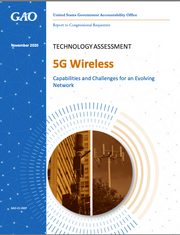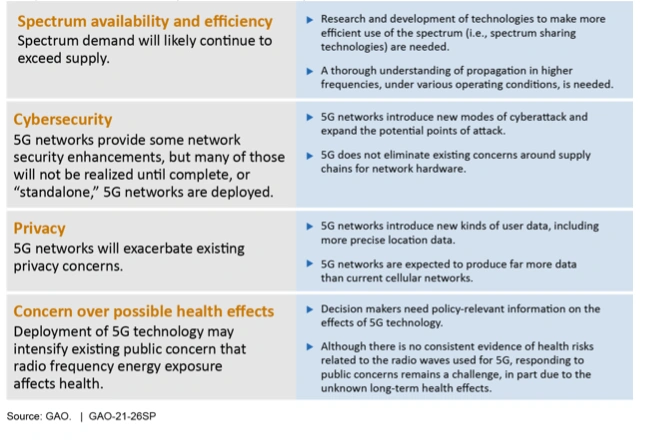Citation[]
Government Accountability Office, 5G Wireless: Capabilities and Challenges for an Evolving Network (GAO-21-26SP) (Nov. 24, 2020) (full-text).

Overview[]
The GAO was asked to assess the technologies associated with 5G and their implications. This report discusses (1) how the performance goals and expected uses are to be realized in U.S. 5G wireless networks, (2) the challenges that could affect the performance or usage of 5G wireless networks in the U.S., and (3) policy options to address these challenges. To address these objectives, GAO interviewed government officials, industry representatives, and researchers about the performance and usage of 5G wireless networks.
Fifth-generation (5G) wireless networks promise to provide significantly greater speeds and higher capacity to accommodate more devices. In addition, 5G networks are expected to be more flexible, reliable, and secure than existing cellular networks. The figure compares 4G and 5G performance goals along three of several performance measures.
Note: Megabits per second (Mbps) is a measure of the rate at which data is transmitted, milliseconds (ms) is a measure of time equal to one thousandth of a second, and square kilometer (km2) is a measure of area.
As with previous generations of mobile wireless technology, the full performance of 5G will be achieved gradually as networks evolve over the next decade. Deployment of 5G network technologies in the U.S. began in late 2018, and these initial 5G networks focus on enhancing mobile broadband. These deployments are dependent on the existing 4G core network and, in many areas, produced only modest performance improvements. To reach the full potential of 5G, new technologies will need to be developed. International bodies that have been involved in defining 5G network specifications will need to develop additional 5G specifications and companies will need to develop, test, and deploy these technologies. The GAO identified the following challenges that can hinder the performance or usage of 5G technologies in the United States.

